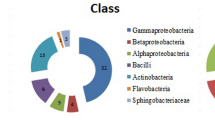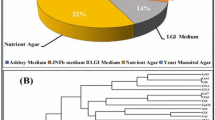Abstract
Plant growth-promoting rhizobacteria (PGPR) are able to promote plant growth using a wide variety of mechanisms as well as provide bioprotection against biotic and abiotic stresses. The objectives of this study were to isolate and characterize putative PGPR associated with rice cultivars with a distinct tolerance to iron toxicity grown in two areas: one area with a well-established history of iron toxicity and another without iron toxicity. Bacterial strains were selectively isolated based on their growth in selective media and were identified by partial sequencing of their 16S rRNA genes. Bacterial isolates were evaluated for their ability to produce indolic compounds, siderophores, and ACC deaminase and to solubilize tricalcium phosphates. In vitro biological nitrogen fixation was evaluated for the bacterial isolates used in the inoculation experiments. A total of 329 bacterial strains were isolated. The composition of the bacterial genera and the occurrence of different plant growth-promoting (PGP) traits were significantly affected by the iron conditions and by the cultivar. Strains belonging to the Burkholderia and Enterobacter genera were the most abundant of all the Gram-negative isolates, and those belonging to the Paenibacillus and Bacillus genera were the most abundant of the Gram-positive isolates. A large number of putative PGPR belonging to different bacterial genera presented several PGP traits. Strains belonging to the Burkholderia, Chryseobacterium, and Ochrobactrum genera contributed to plant growth as well as to enhanced nutrient uptake of the rice plants in in vivo experiments. Growth and nutrient uptake of plants inoculated with isolate FeS53 (Paenibacillus sp.) in the presence of an iron excess were similar to those of plants submitted to the control iron condition, indicating that this bacterium can mitigate the effects caused by iron stress.


Similar content being viewed by others
References
Adesemoye AO, Torbert HA, Kloepper JW (2009) Plant growth-promoting rhizobacteria allow reduced application rates of chemical fertilizers. Microb Ecol 58:921–929
Ali ZS, Sandhya V, Grover M, Kishore N, Rao LV, Venkateswarlu B (2009) Pseudomonas sp. strain AKM-P6 enhances tolerance of sorghum seedlings to elevated temperatures. Biol Fertil Soils 46:45–55
Ambrosini A, Beneduzi A, Stefanski T, Pinheiro FG, Vargas LK, Passaglia LMP (2012) Screening of plant growth promoting Rhizobacteria isolated from sunflower (Helianthus annuus L.). Plant Soil 356:245–264
Ando T, Yoshida S, Nishiyama I (1983) Nature of oxidizing power of rice roots. Plant Soil 72:57–71
Andrews SC, Robinson AK, Rodríguez-Quinõnes F (2003) Bacterial iron homeostasis. FEMS Microbiol Ver 27:215–237
Arruda L, Beneduzi A, Martins A, Lisboa B, Lopes C, Bertolo F, Passaglia LMP, Vargas LK (2013) Screening of rhizobacteria isolated from maize (Zea mays L.) in Rio Grande do Sul State (South Brazil) and analysis of their potential to improve plant growth. Appl Soil Ecol 63:15–22
Arshad M, Shaharoona B, Mahmood T (2008) Inoculation with Pseudomonas spp. containing ACC-deaminase partially eliminates the effects of drought stress on growth, yield, and ripening of pea (Pisum sativum L.). Pedosphere 18:611–620
Bacha RE, Ishiy T (1986) Toxicidad por hierro en arroz: metodologia para seleccionar genótipos resistentes en Brasil. Bol Informativo del Programa de Arroz del CIAT 7:1–4
Bal HB, Nayak L, Das S, Adhya TK (2013) Isolation of ACC deaminase producing PGPR from rice rhizosphere and evaluating their plant growth promoting activity under salt stress. Plant Soil 366:93–105
Becker M, Asch F (2005) Iron toxicity in rice-conditions and management concepts. J Plant Nutr Soil Sci 68:558–573
Beneduzi A, Peres D, Vargas LK, Bodanese-Zanettini MH, Passaglia LMP (2008) Evaluation of genetic diversity and plant growth promoting activities of nitrogen-fixing bacilli isolated from rice fields in South Brazil. Appl Soil Ecol 39:311–320
Bhattacharyya PN, Jha DK (2012) Plant growth-promoting rhizobacteria (PGPR): emergence in agriculture. World J Microbiol Biotechnol 28:1327–1350
Boddey RM (1987) Methods for quantification of nitrogen fixation associated with gramineae. Crit Rev Plant Sci 6:209–266
Bradford MM (1976) A rapid and sensitive method for the quantitation of microgram quantities of protein utilizing the principle of protein-dye binding. Anal Biochem 72:248–254
Briones AM, Okabe S, Umemiya Y, Ramsing N, Reichardt W, Okuyama H (2002) Influence of different cultivars on populations of ammonia-oxidizing bacteria in the root environment of rice. Appl Environ Microbiol 68:3067–3075
Costa P, Beneduzi A, Souza R, Schoenfeld R, Vargas LK, Passaglia LMP (2013) The effects of different fertilization conditions on bacterial plant growth promoting traits: guidelines for directed bacterial prospection and testing. Plant Soil 368:267–280
Deepa CK, Syed G, Dastager SG, Pandey A (2010) Isolation and characterization of plant growth promoting bacteria from non-rhizospheric soil and their effect on cowpea (Vigna unguiculata (L.) Walp.) seedling growth. World J Microbiol Biotechnol 26:1233–1240
Dimkpa C, Weinand T, Asch F (2009a) Plant-rhizobacteria interactions alleviate abiotic stress conditions. Plant Cell Environ 32:1682–1694
Dimkpa C, Merten D, Svatos A, Buchel G, Kothe E (2009b) Metal-induced oxidative stress impacting plant growth in contaminated soil is alleviated by microbial siderophores. Soil Biol Biochem 41:154–162
Dixon R, Kahn D (2004) Genetic regulation of biological nitrogen fixation. Nature 2:621–631
Döbereiner J (1988) Isolation and identification of root associated diazotrophs. Plant Soil 110:207–212
Dobermann A, Fairhurst TH (2000) Rice: Nutrient disorders and nutrient management. The International Rice Research Institute, Manila
Edwards U, Rogall T, Blockerl H, Emde M, Bottger EC (1989) Isolation and direct complete nucleotide determination of entire genes. Characterization of a gene coding for 16S ribosomal RNA. Nucleic Acids Res 17:7843–7853
Figueiredo VB, Burity HA, Martínez CR, Chanway CP (2008) Alleviation of drought stress in the common bean (Phaseolus vulgaris L.) by co-inoculation with Paenibacillus polymyxa and Rhizobium tropici. Appl Soil Ecol 40:182–188
Garbeva P, Van Veen JA, Van Elsas JD (2003) Predominant Bacillus spp. in agricultural soil under different management regimes detected via PCR-DGGE. Microb Ecol 45:302–316
Glick B (2012) Plant growth-promoting bacteria: mechanisms and applications. Scientifica 2012:1–15. Available at: http://dx.doi.org/10.6064/2012/963401
Glickmann E, Dessaux Y (1995) A critical examination of the specificity of the Salkowski Reagent for indolic compounds produced by phytopathogenic bacteria. Appl Environ Microbiol 61:793–796
Grover M, Ali SZ, Sandhya V, Rasul A, Venkateswarlu B (2011) Role of microorganisms in adaptation of agriculture crops to abiotic stresses. World J Microbiol Biotechnol 27:1231–1240
Gyaneshwar P, Hirsch AM, Moulin L, Chen WM, Elliott GN, Bontemps C, Estrada-de Los Santos P, Gross E, Dos Reis FB, Sprent JI, Young JP, James EK (2011) Legume-nodulating betaproteobacteria: diversity, host range, and future prospects. Mol Plant-Microbe Interact 24(11):1276–1288
Inceoglu Ö, Salles JF, Van Elsas JD (2012) Soil and cultivar type shape the bacterial community in the potato rhizosphere. Microb Ecol 63:460–470
Kobayashi T, Nishizawa NK (2012) Iron uptake, translocation, and regulation in higher plants. Annu Rev Plant Biol 63:131–152
Kraepiel AML, Bellenger JP, Wichard T, Morel FMM (2009) Multiple roles of siderophores in free-living nitrogen-fixing bacteria. Biometals 22:573–581
Lemanceau P, Bauer P, Kraemer S, Briat JF (2009) Iron dynamics in the rhizosphere as a case study for analyzing interactions between soils, plants and microbes. Plant Soil 321:513–535
Lugtenberg B, Kamilova F (2009) Plant-growth-promoting rhizobacteria. Annu Rev Microbiol 63:541–546
Mehraban P, Zadeh A, Sadeghipour H (2008) Iron toxicity in rice (Oryza sativa L.), under different potassium Nutrition. Asian J Plant Sci 7:251–25
Palmer KM, Young JPW (2000) Higher diversity of Rhizobium leguminosarum biovar viciae populations in arable soils than in grasssoils. Appl Environ Microbiol 66:2445–2450
Penrose DM, Glick BR (2003) Methods for isolating and characterizing ACC deaminase-containing plant growth promoting rhizobacteria. Physiol Plant 118:10–15
Rico A, Ortiz-Barredo A, Ritter E, Murillo J (2004) Genetic characterization of Erwinia amylovora strains by amplified fragment length polymorphism. J Appl Microbiol 96:302–310
Sambrook J, Russel DW (2001) Molecular cloning: a laboratory manual. Cold Spring Harbor Laboratory Press, New York
Sasaki K, Ikeda S, Eda S, Mitsui H, Hanzawa E, Kisara C, Kazama Y, Kushida A, Shinano T, Minamisawa K, Sat T (2010) Impact of plant genotype and nitrogen level on rice growth response to inoculation with Azospirillum sp. strain B510 under paddy field conditions. Soil Sci Plant Nutr 56:636–644
Schwyn B, Neilands JB (1987) Universal chemical assay for the detection and determination of siderophores. Anal Biochem 160:47–56
Seldin L, Van Elsas JD, Penido EGC (1983) Bacillus nitrogens fixers from Brazilian soils. Plant Soil 70:243–255
Shannon CE, Weaver W (1949) The mathematical theory of communication. University of Illinois Press, Urbana
Souza R, Beneduzi A, Ambrosini A, Costa PB, Meyer J, Vargas LK, Schoenfeld R, Passaglia LMP (2013) The effect of plant growth-promoting rhizobacteria on the growth of rice (Oryza sativa L.) cropped in southern Brazilian fields. Plant Soil 366:585–603
Sparks DL, Page AL, Helmke PA, Loeppert RH, Soltanpour PN, Tabatabai MA, Johnston CT, Sumner ME (eds) (1996) Methods of soil analysis: chemical methods. Part 3. Soil Science Society of America/American Society of Agronomy, Madison
Stackebrandt E, Liesack W (1993) Nucleic acids and classification. Academic Press, London
Stein RJ, Duarte GL, Spohr MG, Lopes SIG, Fett JP (2009) Distinct physiological responses of two rice cultivars subjected to iron toxicity under field conditions. Ann Appl Biol 154:269–277
Upadhyay SK, Singh DP, Saikia R (2009) Genetic diversity of plant growth promoting rhizobacteria isolated from rhizospheric soil of wheat under saline condition. Curr Microbiol 59:489–496
Yadav S, Kaushik R, Saxena AK, Arora DK (2011) Diversity and phylogeny of plant growth-promoting bacilli from moderately acidic soil. J Basic Microbiol 51:98–106
Yoshida S (1981) Fundamentals of rice crop science. The International Rice Research Institute, Los Baños, pp 1–61
Acknowledgments
This work was financed by grants and fellowships from the Fundação de Amparo à Pesquisa do Estado do Rio Grande do Sul (FAPERGS/Brasil), Conselho Nacional de Desenvolvimento Científico e Tecnológico (CNPq/Brasil), and INCT da Fixação Biológica do Nitrogênio (Brasil).
Author information
Authors and Affiliations
Corresponding author
Rights and permissions
About this article
Cite this article
de Souza, R., Meyer, J., Schoenfeld, R. et al. Characterization of plant growth-promoting bacteria associated with rice cropped in iron-stressed soils. Ann Microbiol 65, 951–964 (2015). https://doi.org/10.1007/s13213-014-0939-3
Received:
Accepted:
Published:
Issue Date:
DOI: https://doi.org/10.1007/s13213-014-0939-3




